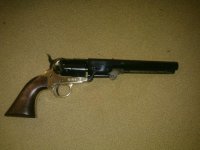georgiacatweazle
New member
Need some advice about conversion cylinders. I've heard that using conversions for brass frames are bad due to increased power of 45LC.
But what about if you handload 45LC to the same foot pounds as black powder ? You get the benefit of less mess.
Not sure what the ft/lb of energy would be of 15gr of BP ? 150 maybe ?
45LC average is 400 ft/lb using 40-50 gr of modern powder, so a light load of 10-15 grains and a lighter cast bullet around 150 grains like the .454 ball
The way i see it, if propellant A has the same forces as propellant method B, then it's apples to apples.
I know some folks would say "get a Ruger X model in 45LC" or "get a steel frame Y pistol", yep, but I also don't have an unlimited budget, got the Pietta as an entry level pistol for $149 and want to get as much mileage out of it as I can, that includes maybe using my soon-to-be-purchased entry level Lee press kit which I could maybe experiment with custom 45LC.
Any one have any opinions ?
Thanks
But what about if you handload 45LC to the same foot pounds as black powder ? You get the benefit of less mess.
Not sure what the ft/lb of energy would be of 15gr of BP ? 150 maybe ?
45LC average is 400 ft/lb using 40-50 gr of modern powder, so a light load of 10-15 grains and a lighter cast bullet around 150 grains like the .454 ball
The way i see it, if propellant A has the same forces as propellant method B, then it's apples to apples.
I know some folks would say "get a Ruger X model in 45LC" or "get a steel frame Y pistol", yep, but I also don't have an unlimited budget, got the Pietta as an entry level pistol for $149 and want to get as much mileage out of it as I can, that includes maybe using my soon-to-be-purchased entry level Lee press kit which I could maybe experiment with custom 45LC.
Any one have any opinions ?
Thanks

